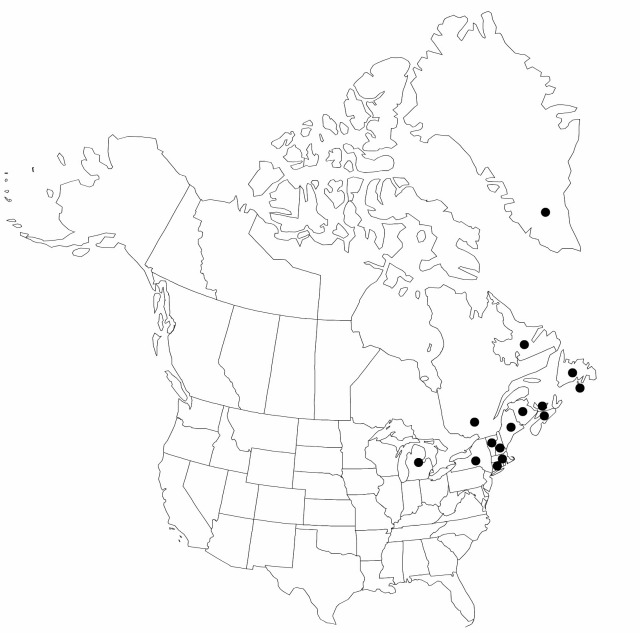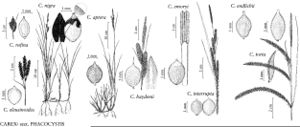Carex nigra
Fl. Moeno-Francof. 2: 96. 1778.
Plants not cespitose. Culms acutely angled, 10–110 cm, scabrous. Leaves: basal sheaths redbrown; sheaths of proximal leaves glabrous, fronts lacking spots and veins, apex truncate; blades epistomic, 2–4.5 mm wide, adaxially papillose. Inflorescences: proximal bract subequal to inflorescence, 1.5–4 mm wide. Spikes erect; proximal 2–3 spikes pistillate, 1.2–4.2 cm × 3–5 mm, base obtuse or acute; terminal 1–2 spikes staminate. Pistillate scales dark purple-brown or black, shorter than perigynia, apex obtuse, awnless. Perigynia ascending, pale-brown with redbrown or black spots on apical 1/2, occasionally black on apical 1/2, 3–9-veined on each face, somewhat flattened, tightly enclosing achenes, stipitate, ellipsoid or obovoid, 2–3.7 × 1.1–2.1 mm, somewhat leathery, dull, base truncate, distended, apex obtuse or rounded, papillose; stipe 0.1–0.3 mm; beak redbrown or black, 0.1–0.2 mm, orifice scabrous. Achenes not constricted, whitish iridescent, base adnate to perigynium. 2n = 83, 84, 85.
Phenology: Fruiting Jul–Aug.
Habitat: Wet meadows
Elevation: 0–200 m
Distribution

Greenland, St. Pierre and Miquelon, N.B., Nfld. and Labr., N.S., P.E.I., Que., Conn., Maine, Mass., Mich., N.H., N.Y., Vt., Europe, w. Asia
Discussion
Plants of Carex nigra are variable in height and degree of development of rhizomes, but are not separable into distinct taxa. Much less morphologic or ecotypic variation appears to exist in North America than in Europe (A. O. Chater 1980). In North America, C. nigra hybridizes with C. stricta, C. aquatilis, C. paleacea, C. subspathacea, and C. salina. It is a member of the C. acuta subgroup, based on the veined, stipitate perigynia distended by the base of the achenes; it differs from the related sympatric C. lenticularis by the rhizomatous habit, dark green leaves, black scales and perigynia, and short inflorescence bract.
Carex nigra appears to be declining in abundance in southern New England as a result of changing patterns of land use and the loss of wet fields and pastures.
Selected References
None.
Lower Taxa
"shortened" is not a number.
